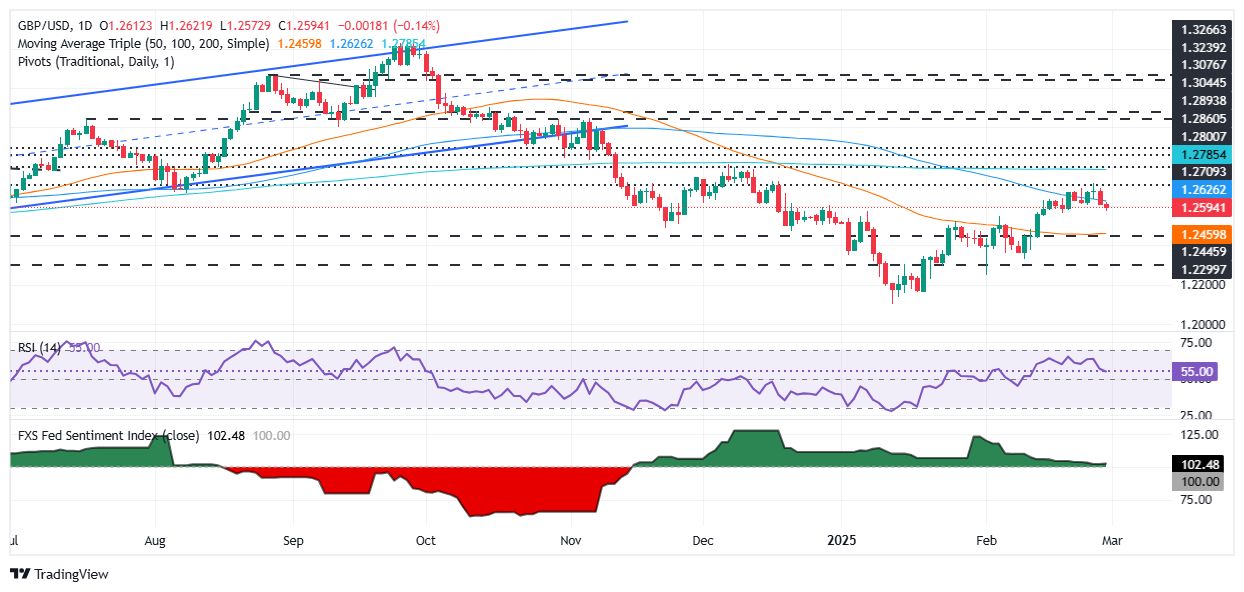GBP/USD struggles at 1.2600 set to first monthly gain since September
- Core PCE rises 2.6% YoY, signaling stalled disinflation but staying near Fed’s target.
- Trump confirms 25% tariffs on Mexico and Canada, adding to trade concerns.
- BoE’s Ramsden sees inflation risks balanced, no longer tilted to the downside.
The Pound Sterling struggles to clear the 1.2600 figure against the US Dollar yet is set for it first monthly gain since September 2024. The Federal Reserve’s (Fed) preferred inflation gauge report was aligned with estimates, hinting that the disinflation process stalled, but it remains near the Fed’s goal. The GBP/USD trades at 1.2607, virtually unchanged.
Pound steadies as US inflation data aligns with expectations
The Core Personal Consumption Expenditures (PCE) Price Index in the US rose 0.3% Month over Month from December and increased 2.6% year over year, as estimated, down from December's 2.8% increase. Headline inflation expanded to 2.5% YoY as expected, dipped from 2.6%, and was unchanged every month as projected at 0.3%.
Meanwhile, traders continued to digest US President Donald Trump's tariff rhetoric. He said 25% tariffs on Mexico and Canada would start next week, alongside an additional 10% on China.
Earlier, Cleveland Fed Beth Hammack said that a rate hike is not in her current outlook, that inflation expectations are still anchored, and that it is unclear how far tariffs could affect the economy and, consequently, monetary policy.
Across the pond, Bank of England (BoE) Governor David Ramsen said that the risks of hitting the 2% inflation target in the medium term are two-sided and no longer tilted to the downside.
GBP/USD Price Analysis: Technical outlook
The GBP/USD has recovered some ground, yet it remains tilted to the downside despite consolidating at around the 1.2549 – 1.2700 range. To extend their gains, buyers must clear the 1.2700 mark, followed by the 200-day Simple Moving Average (SMA) at 1.2785. Further gains are seen above 1.2800.
Conversely, if sellers keep the major from closing daily above 1.2600, this could pave the way for a test of the 1.2549 February 5 daily peak. If surpassed, sellers could challenge the 50-day SMA at 1.2457.

Pound Sterling FAQs
The Pound Sterling (GBP) is the oldest currency in the world (886 AD) and the official currency of the United Kingdom. It is the fourth most traded unit for foreign exchange (FX) in the world, accounting for 12% of all transactions, averaging $630 billion a day, according to 2022 data. Its key trading pairs are GBP/USD, also known as ‘Cable’, which accounts for 11% of FX, GBP/JPY, or the ‘Dragon’ as it is known by traders (3%), and EUR/GBP (2%). The Pound Sterling is issued by the Bank of England (BoE).
The single most important factor influencing the value of the Pound Sterling is monetary policy decided by the Bank of England. The BoE bases its decisions on whether it has achieved its primary goal of “price stability” – a steady inflation rate of around 2%. Its primary tool for achieving this is the adjustment of interest rates. When inflation is too high, the BoE will try to rein it in by raising interest rates, making it more expensive for people and businesses to access credit. This is generally positive for GBP, as higher interest rates make the UK a more attractive place for global investors to park their money. When inflation falls too low it is a sign economic growth is slowing. In this scenario, the BoE will consider lowering interest rates to cheapen credit so businesses will borrow more to invest in growth-generating projects.
Data releases gauge the health of the economy and can impact the value of the Pound Sterling. Indicators such as GDP, Manufacturing and Services PMIs, and employment can all influence the direction of the GBP. A strong economy is good for Sterling. Not only does it attract more foreign investment but it may encourage the BoE to put up interest rates, which will directly strengthen GBP. Otherwise, if economic data is weak, the Pound Sterling is likely to fall.
Another significant data release for the Pound Sterling is the Trade Balance. This indicator measures the difference between what a country earns from its exports and what it spends on imports over a given period. If a country produces highly sought-after exports, its currency will benefit purely from the extra demand created from foreign buyers seeking to purchase these goods. Therefore, a positive net Trade Balance strengthens a currency and vice versa for a negative balance.

